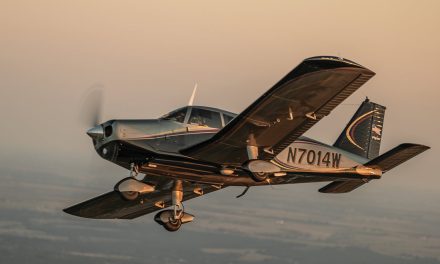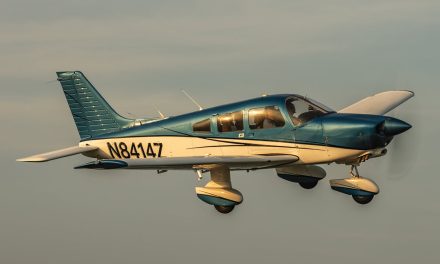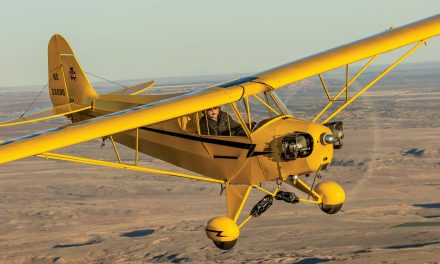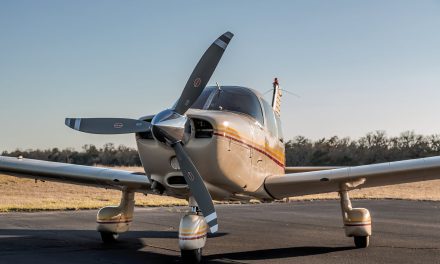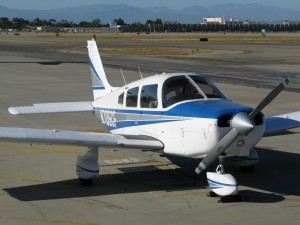 Featured Plane
Featured Plane
A Warrior with ENTHUSIASM
How to “Boldly” Promote your Warrior to an Archer
It seems Cherokees are forever. At least, we hope they are. As the low wing alternative to Cessna’s popular Skyhawk, the Piper Warrior was one of the Vero Beach-based company’s most successful airplanes.
Designed by Carl Bergey, John Thorp, and Fred Weick, the precursor, fat-wing Cherokees with rectangular airfoils came on the market in 1960, offered initially with either 150 or 160 hp. This led to the Warrior variation in 1974, a model that featured a semi-tapered airfoil, modestly improved control response, and slightly better performance. Produced between 1974 and 2012, the Warrior was Piper’s entry-level trainer. (OK, there was the Tomahawk and the short-lived Piper Sport, but the Warrior was ever-present, gentle, reliable, and as stable as a table.
Piper built literally thousands of Warriors—most for the training market, but a significant number for small family transport, the so-called 2+2 segment. No one knows just how many were flown for each group; however one thing is sure: The sheer number built and concentration of flight hours meant Warriors were prime candidates for options when it came time for an engine overhaul.
Imagine for a moment that you’re an owner of a Warrior with a run out engine. Your Lycoming has just over 2200 hours on its second or third overhaul, and you’re faced with a decision of what to do next.
You have a number of options. First, you could try for another overhaul, though that can be problematic. Second, you could purchase a rebuilt Lycoming O-320 engine. Third, you might sell the airplane as is, take the financial hit, and leave the problem to someone else. But then, what would you fly?
Of these three choices, the second seems the most logical, assuming you’d like to keep the airplane.
There is a fourth option that Warrior owners might want to consider, however. You could convert your stock O-320 Lycoming to an O-360, upgrading combustion capacity by 40 cubic inches and adding 20-30 hp in the process.
Despite the powerplant’s greater displacement and horsepower, the physical differences between the two engines are minimal. The O-360 weighs only about 18 pounds more than the O-320, and the two Lycomings displace similar space under the cowling.
The result in performance is roughly the equivalent of a Piper Archer, though there are some additional changes on the Archer that would not be addressed on a simple engine upgrade to a Cherokee 140/150/160/Warrior.
Bob Small of Mesa, Arizona, is the owner of the Bold Warrior STC that allows Piper owners to step up from 160 to 180 hp. Small created the mod 35 years ago as part of a larger project to basically rebuild a Warrior into an Archer, in case you hadn’t guessed. This included a variety of other mods, but of course, the primary improvement was upgrading the airplane by 20-30 hp. (The very early Warriors were fitted with 150-hp Lycomings, whereas the later models came standard with 160-hp mills.)
Adding that much extra power to a standard Cherokee Warrior grants a shot of enthusiasm that you’ll very likely notice during climb, though not so much at cruise. In fact, adding horsepower all by itself isn’t a very efficient method of adding knots, primarily because drag increases as the square of speed. This means it requires disproportionately more horsepower to generate a relatively small increase in speed.
To use an extreme example, my late friend and former TWA Captain, Lyle Shelton, upgraded the engine on his WWII Grumman F8F Navy fighter, “Rare Bear,” from a 2000-hp P&W R2800 to a Wright R3350, increasing power by probably 1000 hp. Shelton was in search of the ultimate racer for the unlimited air race circuit. The TWA captain realized his greatest speed improvement, however, when he chopped four feet off each wingtip, reduced cooling drag, cut down the sliding canopy, and made about three dozen other aerodynamic improvements that dramatically reduced the airplane’s drag signature. “Rare Bear” subsequently won 11 unlimited class races and still holds the world prop/piston speed record at 528 mph, set in Las Vegas, New Mexico twenty-five years ago. Shelton’s F8 also holds the world prop/piston time to climb record – 91.9 seconds from sea level to 10,000 feet.
Bob Small’s goals were considerably less ambitious. Small created the Bold Warrior in the early 1980s, utilizing an early Warrior airframe featuring a totally revamped interior, a modernized avionics package, and a number of other upgrades that round out the improvements. His original premise was to offer a complete package of revisions that would transform a ‘70s vintage PA-28-151/161 to near new condition. Small reasoned that if the conversion came with its own characteristic paint and interior, it might be more attractive than a simple engine swap.
Of course, the big draw was/is the switch to a 180-hp Lycoming O-360-A4M powerplant, 20/30 hp stronger than the original Warrior and about 18 pounds heavier than the stock O-320. In order to preserve a reasonable CG, Small moved the prop back three inches. Other than that, there are no significant operational changes to the airplane and the control harmony remains unchanged.
Here come the numbers: According to Jane’s-All-the-World’s Aircraft, Warriors had a gross weight of 2325 pounds and a base empty weight of 1344 pounds. But remember, that was new weight and wouldn’t apply to the same airplane today. (I often wonder, if you bought an airplane in 1975, parked it in a hangar for 35 years, and then took it out and weighed it today, would it magically have gained 100 pounds?)
Airplanes (like people) inexplicably gain weight with age. Today, a typical late-70s Warrior checks in at more like 1450-1500 pounds empty. This leaves a useful load of roughly 825 pounds. Subtract 288 pounds of fuel (48 gallons), and you’re left with 537 paying pounds.
While that’s typically not four, full-sized folk’s worth, it compares favorably to the payload of most modern, fixed-gear, fixed-pitch prop four-seaters on today’s market. In fact, many of the older airplanes actually score better in load-lifting than the new, 21st century machines. Despite the Archer’s, higher gross weight (2550 pounds), I’d bet payload on the two airplanes is very similar, as a buck naked PA-28-181 probably weighs a realistic 100 pounds more than the day it was born.
The airplane I flew for this evaluation is owned by Dale Stanbridge and his son, Alex, of Mesa, Arizona. Stanbridge purchased his Bold Warrior specifically because of its improved performance and ability to operate in and around the Phoenix area during the hot summer weather. “I’d been out of aviation for over 20 years. So when my son showed an interest in learning to fly, I was delighted to buy him 20 hours of dual in a 150,” Standbridge explains. “He got me interested in getting a biennial flight review and a new medical. Alex is only nine, but I can thank him for returning me to aviation.”
Stanbridge’s interest in flying goes well beyond that of most pilots. He’s an aerospace engineer employed by a firm that subcontracts thru Johns-Hopkins in Maryland to work with NASA providing guidance and control on a number of current space missions. The New Horizons probe has been in transit to Pluto for nine years and will reach the planetoid in 2015 after a three billion mile journey. It will then fly on to explore the Kuiper Belt on the edge of interstellar space. The New Horizon mission is the fastest vehicle ever to be launched into space, coasting through the void at just under 40,000 mph.
Meanwhile, back here on Earth, Stanbridge’s Warrior isn’t quite so quick, but it has the advantage of carrying four folks. The engineer’s PA-28-161 conversion has an empty weight of 1457 pounds against a slightly increased 2440 pound gross weight, so useful load on this modestly-equipped people mover works out to 983 pounds. Subtract 48 gallons of fuel and you’re left with a moderately impressive 695 pound payload. In theory, you could load four, full-size FAA folks on board with topped tanks and fly away.
Whatever the load, don’t expect a major change in takeoff acceleration with only 20-30 extra horsepower out front, but you can anticipate a slightly stronger push in the back and better short field performance. Since I was flying the “after” airplane, there was no convenient method of comparing runway usage, but it stands to reason that the Warrior conversion should jump off quicker and start uphill more aggressively than a stock PA-28-161.
I saw an initial 800 fpm in Stanbridge’s airplane climbing out of Long Beach, California, with three folks on board and two-thirds fuel on a warm July day. To no one’s surprise, that’s about what you’d see from an Archer. Even in cruise climb at 100 knots, the airplane managed 500 fpm—not spectacular, but impressive on a hot day.
Leveling at 4500 feet beneath the class B airspace, Stanbridge’s Bold Warrior scored a solid 127 knots on a two-way GPS run at 4500 feet off the California Coast. That’s about eight knots quicker than a standard Warrior and roughly the same as an Archer’s top cruise. It’s also equal to a C172R’s best efforts.
It’s no great surprise that performance is comparable to that of Cessna’s final evolution Skyhawk, the 172S. The Cessna uses essentially the same powerplant and the same size wing, so it posts nearly the same climb as the Archer or Dale Stanbridge’s clever imitation. The Skyhawk and Archer have long been direct competitors, and preferring one over the other often devolves to the type of airplane a student trained in, high wing or low wing.
Indeed, that’s long been the mission of the entry-level, four-seat singles—to introduce new pilots to Piper’s and Cessna’s respective quartet transports in hopes they’ll eventually step up to higher-powered models with more seating capacity.
The great joy of all the Cherokees, though, is that they’re almost ridiculously easy-flying airplanes, well-suited to any skill level. Stalls are almost non-existent and even departure stalls wrapped over to 45 degrees. The airplane barely bobs its nose before settling into a gentle Maule-like mush downhill.
Pattern manners are similarly docile, and landings come easily to most pilots who are simply awake. Stanbridge uses a 70-75 knot approach speed with full flaps, and the airplane settles onto the runway with a minimum of fuss.
Like the Skyhawk, the Warrior has always been revered for its gentle manners, simple operation, and economical hourly costs. Bob Small’s conversion to 180 hp enhances practically every aspect of the Warrior’s personality. Each buyer will need to make his own decision of value versus cost.
For more information about the Bold Warrior conversion, applicable to Piper Warriors from 1977 through 1983, contact Bob Small at bsmall1940@gmail.com or call him at 480-330-1927.
Specifications & Performance – 1979 Piper Warrior II
All specifications and performance figures are drawn from official sources, often the aircraft flight manual or the manufacturer’s web site. Another reliable source of information is Jane’s All-the-World’s Aircraft. Specifications on older aircraft will not always agree as several sources may disagree on performance. Since this is a modified aircraft (with an FAA STC), performance and weights may be better than book. Specifications for cruise and climb were observed.
Specifications
Engine(s)-make/model: Lycoming O-360-A4M
Hp: 180
Fuel type: 100LL
Landing gear type: FXD/TRI
Max TO weight (lbs): 2440
Empty weight (lbs): 1457
Useful load–std (lbs): 983
Usable fuel–std (gal/lbs): 48/288
Payload–full std fuel (lbs): 645
Wingspan: 35’
Overall length: 23’ 7”
Height: 7’ 5”
Wing area (sq ft): 170
Wing loading (lbs/sq ft): 14.4
Power loading (lbs/hp): 13.6
Seating capacity: 4
Cabin doors: 1
Cabin width (in): 41
Cabin height (in): 49
Performance
Cruise speed (kts–75%): 127
Cruise Fuel Burn (gph/lbs): 9.5
Best rate of climb, SL (fpm): 800
Service Ceiling (ft): 14,000
Stall (Vso – kts): 50
TO over 50 ft (ft): 1490
Ldg over 50 ft (ft): 1115

